Cultural Differences: Australia vs. Japan for Business Expansion
VerifiedAdded on 2020/03/04
|9
|2187
|46
Report
AI Summary
This report provides a comparative analysis of the cultural differences between Australia and Japan, focusing on their implications for business development. It utilizes the six-dimensional model, including power distance, individualism, masculinity, uncertainty avoidance, long-term orientation, and indulgence, to highlight the distinct cultural values and business practices of both countries. The report explains how Emily, an entrepreneur, needs to understand these differences to successfully expand her business into Japan. It contrasts Australia's low power distance and high individualism with Japan's intermediate power distance and collectivistic tendencies, along with their contrasting approaches to masculinity, uncertainty avoidance, long-term orientation, and indulgence. The analysis emphasizes the importance of adapting business strategies to align with the specific cultural nuances of the Japanese market, drawing on academic sources to support its findings.

ASSESSMENT 2
Paraphrase This Document
Need a fresh take? Get an instant paraphrase of this document with our AI Paraphraser

Table of Content
Introduction:...............................................................................................................................................2
Conclusion:..................................................................................................................................................6
Reference:...................................................................................................................................................7
Introduction:...............................................................................................................................................2
Conclusion:..................................................................................................................................................6
Reference:...................................................................................................................................................7
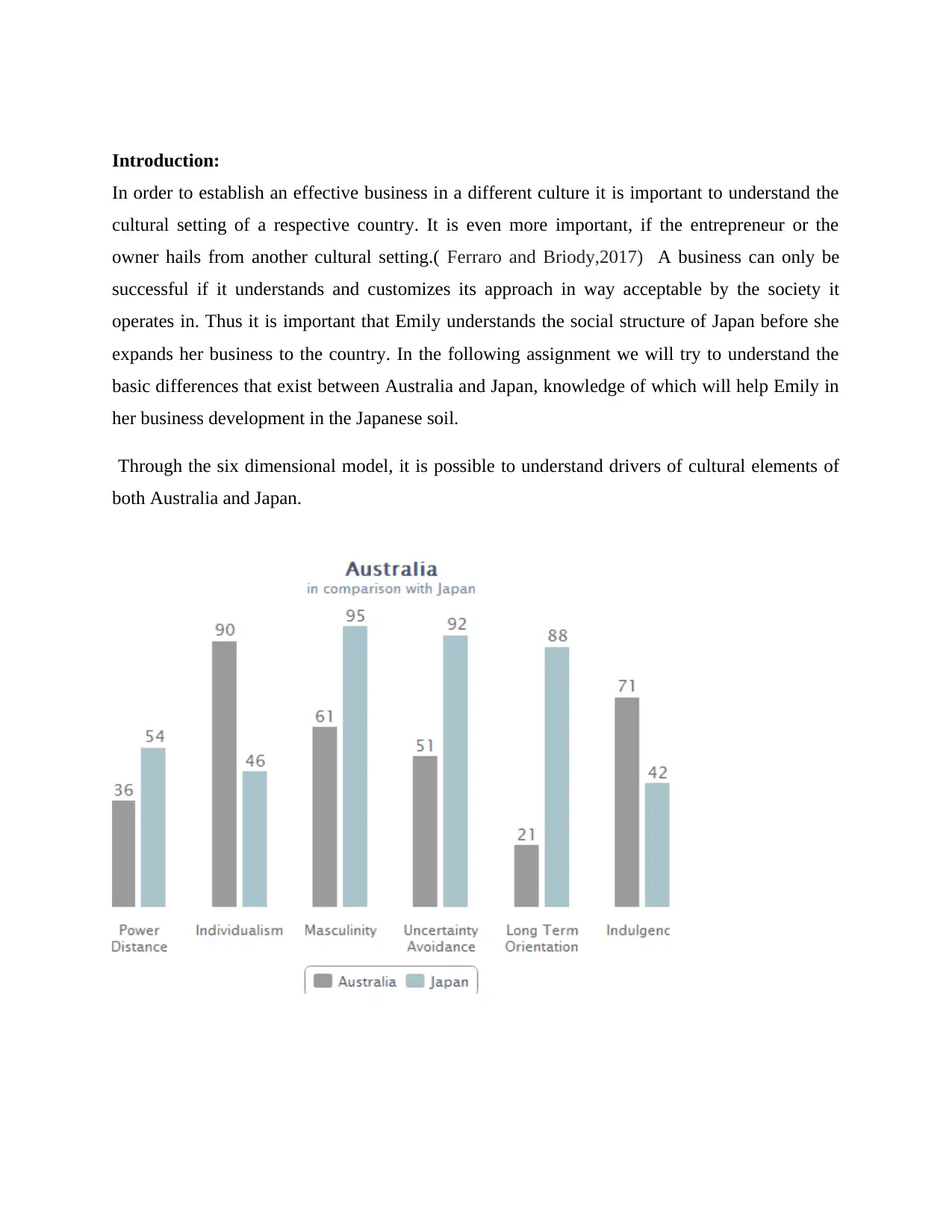
Introduction:
In order to establish an effective business in a different culture it is important to understand the
cultural setting of a respective country. It is even more important, if the entrepreneur or the
owner hails from another cultural setting.( Ferraro and Briody,2017) A business can only be
successful if it understands and customizes its approach in way acceptable by the society it
operates in. Thus it is important that Emily understands the social structure of Japan before she
expands her business to the country. In the following assignment we will try to understand the
basic differences that exist between Australia and Japan, knowledge of which will help Emily in
her business development in the Japanese soil.
Through the six dimensional model, it is possible to understand drivers of cultural elements of
both Australia and Japan.
In order to establish an effective business in a different culture it is important to understand the
cultural setting of a respective country. It is even more important, if the entrepreneur or the
owner hails from another cultural setting.( Ferraro and Briody,2017) A business can only be
successful if it understands and customizes its approach in way acceptable by the society it
operates in. Thus it is important that Emily understands the social structure of Japan before she
expands her business to the country. In the following assignment we will try to understand the
basic differences that exist between Australia and Japan, knowledge of which will help Emily in
her business development in the Japanese soil.
Through the six dimensional model, it is possible to understand drivers of cultural elements of
both Australia and Japan.
⊘ This is a preview!⊘
Do you want full access?
Subscribe today to unlock all pages.

Trusted by 1+ million students worldwide
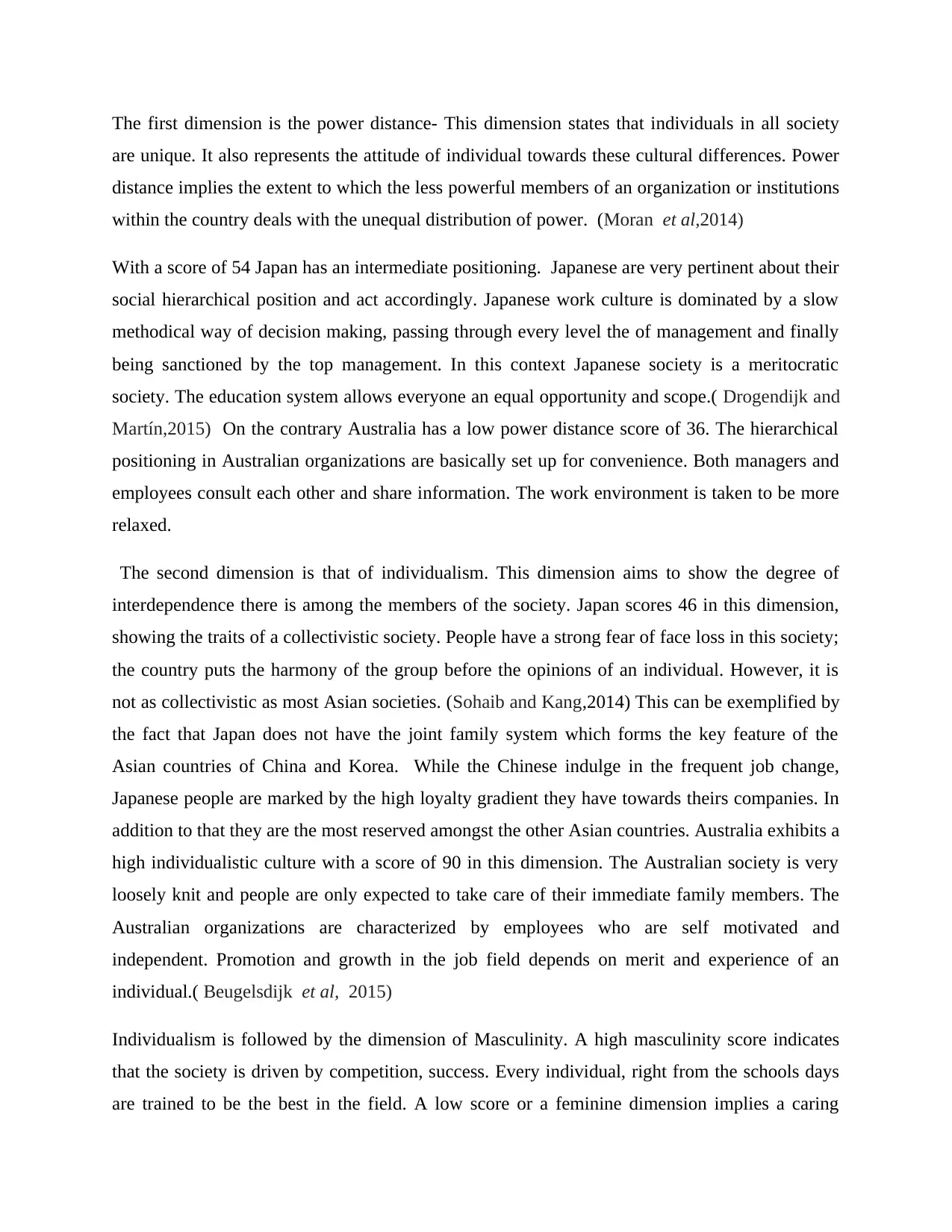
The first dimension is the power distance- This dimension states that individuals in all society
are unique. It also represents the attitude of individual towards these cultural differences. Power
distance implies the extent to which the less powerful members of an organization or institutions
within the country deals with the unequal distribution of power. (Moran et al,2014)
With a score of 54 Japan has an intermediate positioning. Japanese are very pertinent about their
social hierarchical position and act accordingly. Japanese work culture is dominated by a slow
methodical way of decision making, passing through every level the of management and finally
being sanctioned by the top management. In this context Japanese society is a meritocratic
society. The education system allows everyone an equal opportunity and scope.( Drogendijk and
Martín,2015) On the contrary Australia has a low power distance score of 36. The hierarchical
positioning in Australian organizations are basically set up for convenience. Both managers and
employees consult each other and share information. The work environment is taken to be more
relaxed.
The second dimension is that of individualism. This dimension aims to show the degree of
interdependence there is among the members of the society. Japan scores 46 in this dimension,
showing the traits of a collectivistic society. People have a strong fear of face loss in this society;
the country puts the harmony of the group before the opinions of an individual. However, it is
not as collectivistic as most Asian societies. (Sohaib and Kang,2014) This can be exemplified by
the fact that Japan does not have the joint family system which forms the key feature of the
Asian countries of China and Korea. While the Chinese indulge in the frequent job change,
Japanese people are marked by the high loyalty gradient they have towards theirs companies. In
addition to that they are the most reserved amongst the other Asian countries. Australia exhibits a
high individualistic culture with a score of 90 in this dimension. The Australian society is very
loosely knit and people are only expected to take care of their immediate family members. The
Australian organizations are characterized by employees who are self motivated and
independent. Promotion and growth in the job field depends on merit and experience of an
individual.( Beugelsdijk et al, 2015)
Individualism is followed by the dimension of Masculinity. A high masculinity score indicates
that the society is driven by competition, success. Every individual, right from the schools days
are trained to be the best in the field. A low score or a feminine dimension implies a caring
are unique. It also represents the attitude of individual towards these cultural differences. Power
distance implies the extent to which the less powerful members of an organization or institutions
within the country deals with the unequal distribution of power. (Moran et al,2014)
With a score of 54 Japan has an intermediate positioning. Japanese are very pertinent about their
social hierarchical position and act accordingly. Japanese work culture is dominated by a slow
methodical way of decision making, passing through every level the of management and finally
being sanctioned by the top management. In this context Japanese society is a meritocratic
society. The education system allows everyone an equal opportunity and scope.( Drogendijk and
Martín,2015) On the contrary Australia has a low power distance score of 36. The hierarchical
positioning in Australian organizations are basically set up for convenience. Both managers and
employees consult each other and share information. The work environment is taken to be more
relaxed.
The second dimension is that of individualism. This dimension aims to show the degree of
interdependence there is among the members of the society. Japan scores 46 in this dimension,
showing the traits of a collectivistic society. People have a strong fear of face loss in this society;
the country puts the harmony of the group before the opinions of an individual. However, it is
not as collectivistic as most Asian societies. (Sohaib and Kang,2014) This can be exemplified by
the fact that Japan does not have the joint family system which forms the key feature of the
Asian countries of China and Korea. While the Chinese indulge in the frequent job change,
Japanese people are marked by the high loyalty gradient they have towards theirs companies. In
addition to that they are the most reserved amongst the other Asian countries. Australia exhibits a
high individualistic culture with a score of 90 in this dimension. The Australian society is very
loosely knit and people are only expected to take care of their immediate family members. The
Australian organizations are characterized by employees who are self motivated and
independent. Promotion and growth in the job field depends on merit and experience of an
individual.( Beugelsdijk et al, 2015)
Individualism is followed by the dimension of Masculinity. A high masculinity score indicates
that the society is driven by competition, success. Every individual, right from the schools days
are trained to be the best in the field. A low score or a feminine dimension implies a caring
Paraphrase This Document
Need a fresh take? Get an instant paraphrase of this document with our AI Paraphraser
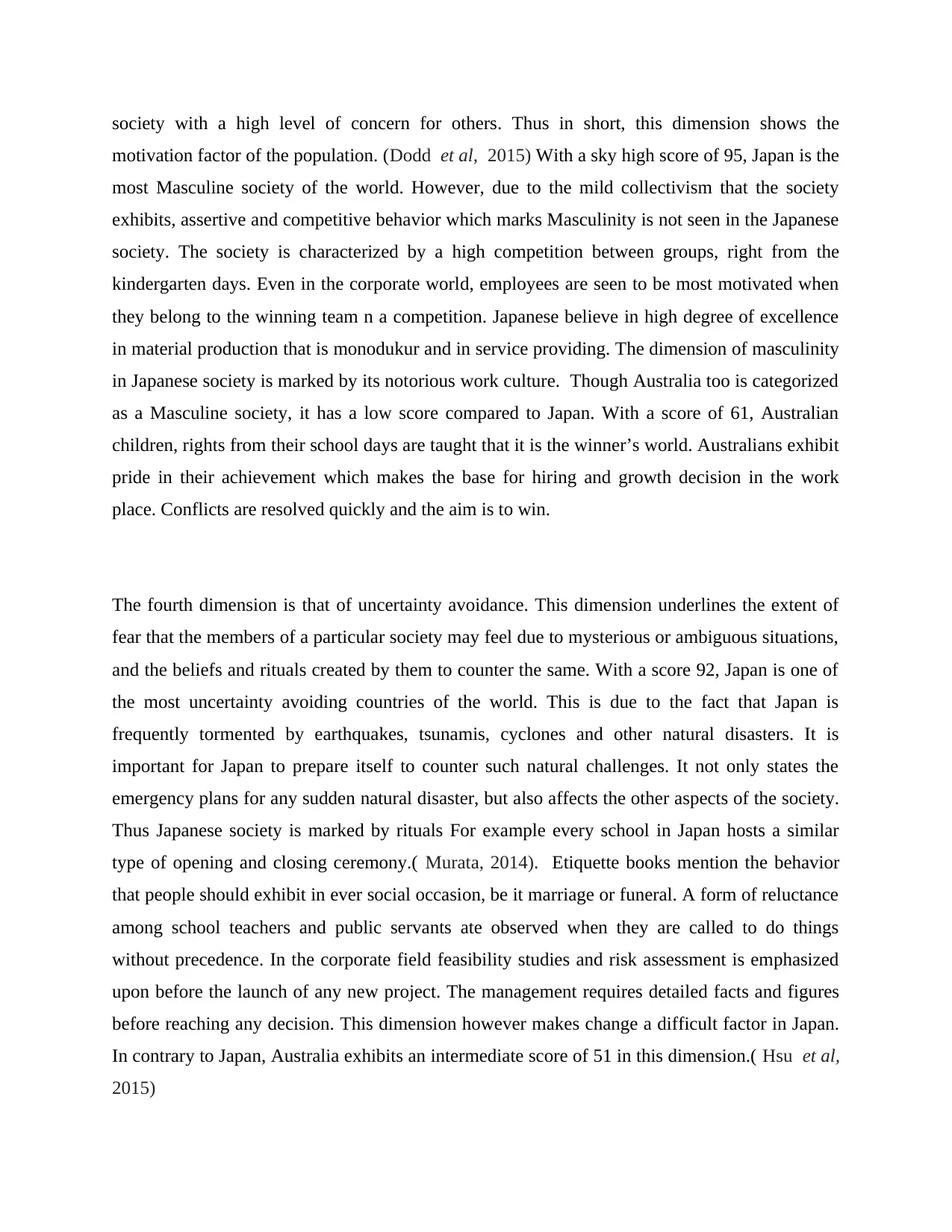
society with a high level of concern for others. Thus in short, this dimension shows the
motivation factor of the population. (Dodd et al, 2015) With a sky high score of 95, Japan is the
most Masculine society of the world. However, due to the mild collectivism that the society
exhibits, assertive and competitive behavior which marks Masculinity is not seen in the Japanese
society. The society is characterized by a high competition between groups, right from the
kindergarten days. Even in the corporate world, employees are seen to be most motivated when
they belong to the winning team n a competition. Japanese believe in high degree of excellence
in material production that is monodukur and in service providing. The dimension of masculinity
in Japanese society is marked by its notorious work culture. Though Australia too is categorized
as a Masculine society, it has a low score compared to Japan. With a score of 61, Australian
children, rights from their school days are taught that it is the winner’s world. Australians exhibit
pride in their achievement which makes the base for hiring and growth decision in the work
place. Conflicts are resolved quickly and the aim is to win.
The fourth dimension is that of uncertainty avoidance. This dimension underlines the extent of
fear that the members of a particular society may feel due to mysterious or ambiguous situations,
and the beliefs and rituals created by them to counter the same. With a score 92, Japan is one of
the most uncertainty avoiding countries of the world. This is due to the fact that Japan is
frequently tormented by earthquakes, tsunamis, cyclones and other natural disasters. It is
important for Japan to prepare itself to counter such natural challenges. It not only states the
emergency plans for any sudden natural disaster, but also affects the other aspects of the society.
Thus Japanese society is marked by rituals For example every school in Japan hosts a similar
type of opening and closing ceremony.( Murata, 2014). Etiquette books mention the behavior
that people should exhibit in ever social occasion, be it marriage or funeral. A form of reluctance
among school teachers and public servants ate observed when they are called to do things
without precedence. In the corporate field feasibility studies and risk assessment is emphasized
upon before the launch of any new project. The management requires detailed facts and figures
before reaching any decision. This dimension however makes change a difficult factor in Japan.
In contrary to Japan, Australia exhibits an intermediate score of 51 in this dimension.( Hsu et al,
2015)
motivation factor of the population. (Dodd et al, 2015) With a sky high score of 95, Japan is the
most Masculine society of the world. However, due to the mild collectivism that the society
exhibits, assertive and competitive behavior which marks Masculinity is not seen in the Japanese
society. The society is characterized by a high competition between groups, right from the
kindergarten days. Even in the corporate world, employees are seen to be most motivated when
they belong to the winning team n a competition. Japanese believe in high degree of excellence
in material production that is monodukur and in service providing. The dimension of masculinity
in Japanese society is marked by its notorious work culture. Though Australia too is categorized
as a Masculine society, it has a low score compared to Japan. With a score of 61, Australian
children, rights from their school days are taught that it is the winner’s world. Australians exhibit
pride in their achievement which makes the base for hiring and growth decision in the work
place. Conflicts are resolved quickly and the aim is to win.
The fourth dimension is that of uncertainty avoidance. This dimension underlines the extent of
fear that the members of a particular society may feel due to mysterious or ambiguous situations,
and the beliefs and rituals created by them to counter the same. With a score 92, Japan is one of
the most uncertainty avoiding countries of the world. This is due to the fact that Japan is
frequently tormented by earthquakes, tsunamis, cyclones and other natural disasters. It is
important for Japan to prepare itself to counter such natural challenges. It not only states the
emergency plans for any sudden natural disaster, but also affects the other aspects of the society.
Thus Japanese society is marked by rituals For example every school in Japan hosts a similar
type of opening and closing ceremony.( Murata, 2014). Etiquette books mention the behavior
that people should exhibit in ever social occasion, be it marriage or funeral. A form of reluctance
among school teachers and public servants ate observed when they are called to do things
without precedence. In the corporate field feasibility studies and risk assessment is emphasized
upon before the launch of any new project. The management requires detailed facts and figures
before reaching any decision. This dimension however makes change a difficult factor in Japan.
In contrary to Japan, Australia exhibits an intermediate score of 51 in this dimension.( Hsu et al,
2015)
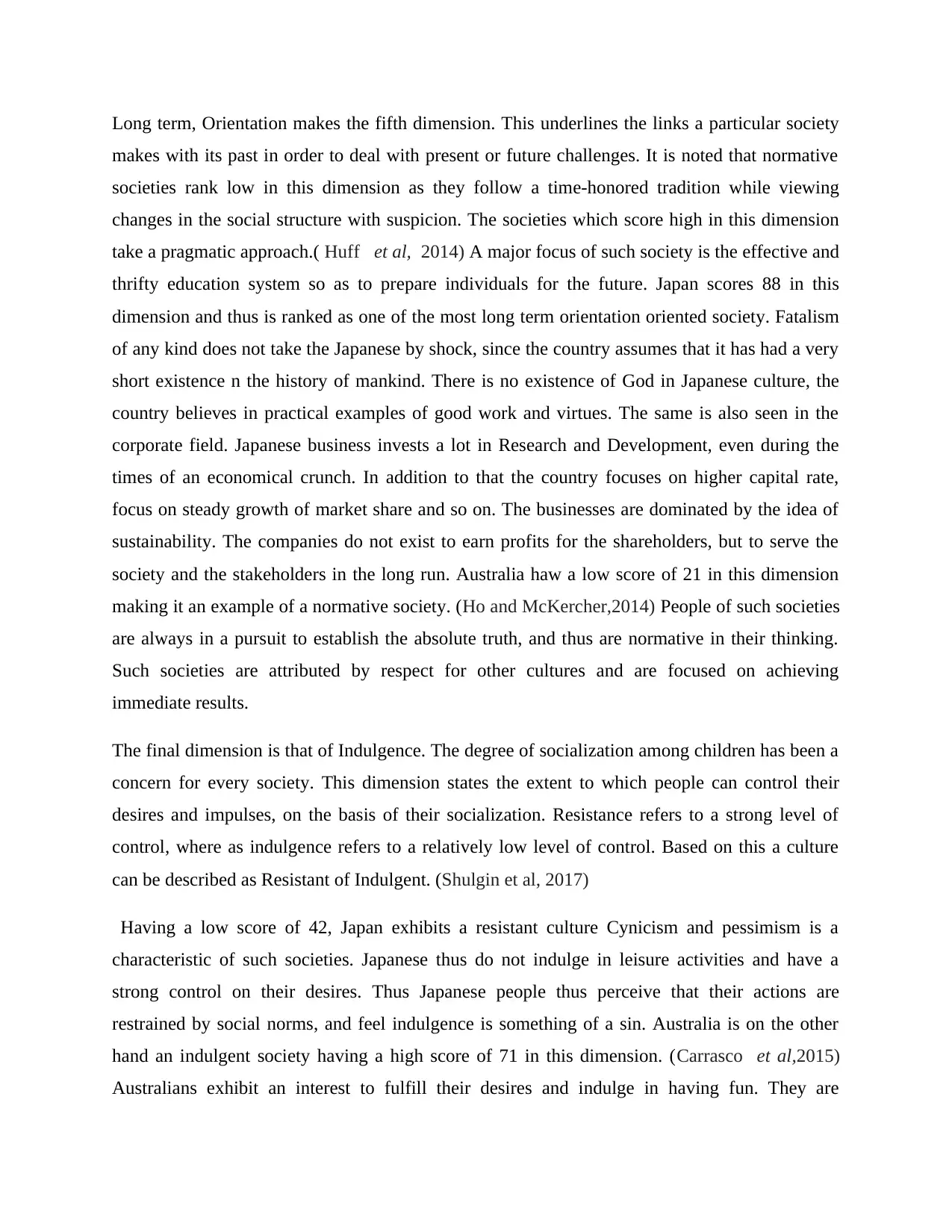
Long term, Orientation makes the fifth dimension. This underlines the links a particular society
makes with its past in order to deal with present or future challenges. It is noted that normative
societies rank low in this dimension as they follow a time-honored tradition while viewing
changes in the social structure with suspicion. The societies which score high in this dimension
take a pragmatic approach.( Huff et al, 2014) A major focus of such society is the effective and
thrifty education system so as to prepare individuals for the future. Japan scores 88 in this
dimension and thus is ranked as one of the most long term orientation oriented society. Fatalism
of any kind does not take the Japanese by shock, since the country assumes that it has had a very
short existence n the history of mankind. There is no existence of God in Japanese culture, the
country believes in practical examples of good work and virtues. The same is also seen in the
corporate field. Japanese business invests a lot in Research and Development, even during the
times of an economical crunch. In addition to that the country focuses on higher capital rate,
focus on steady growth of market share and so on. The businesses are dominated by the idea of
sustainability. The companies do not exist to earn profits for the shareholders, but to serve the
society and the stakeholders in the long run. Australia haw a low score of 21 in this dimension
making it an example of a normative society. (Ho and McKercher,2014) People of such societies
are always in a pursuit to establish the absolute truth, and thus are normative in their thinking.
Such societies are attributed by respect for other cultures and are focused on achieving
immediate results.
The final dimension is that of Indulgence. The degree of socialization among children has been a
concern for every society. This dimension states the extent to which people can control their
desires and impulses, on the basis of their socialization. Resistance refers to a strong level of
control, where as indulgence refers to a relatively low level of control. Based on this a culture
can be described as Resistant of Indulgent. (Shulgin et al, 2017)
Having a low score of 42, Japan exhibits a resistant culture Cynicism and pessimism is a
characteristic of such societies. Japanese thus do not indulge in leisure activities and have a
strong control on their desires. Thus Japanese people thus perceive that their actions are
restrained by social norms, and feel indulgence is something of a sin. Australia is on the other
hand an indulgent society having a high score of 71 in this dimension. (Carrasco et al,2015)
Australians exhibit an interest to fulfill their desires and indulge in having fun. They are
makes with its past in order to deal with present or future challenges. It is noted that normative
societies rank low in this dimension as they follow a time-honored tradition while viewing
changes in the social structure with suspicion. The societies which score high in this dimension
take a pragmatic approach.( Huff et al, 2014) A major focus of such society is the effective and
thrifty education system so as to prepare individuals for the future. Japan scores 88 in this
dimension and thus is ranked as one of the most long term orientation oriented society. Fatalism
of any kind does not take the Japanese by shock, since the country assumes that it has had a very
short existence n the history of mankind. There is no existence of God in Japanese culture, the
country believes in practical examples of good work and virtues. The same is also seen in the
corporate field. Japanese business invests a lot in Research and Development, even during the
times of an economical crunch. In addition to that the country focuses on higher capital rate,
focus on steady growth of market share and so on. The businesses are dominated by the idea of
sustainability. The companies do not exist to earn profits for the shareholders, but to serve the
society and the stakeholders in the long run. Australia haw a low score of 21 in this dimension
making it an example of a normative society. (Ho and McKercher,2014) People of such societies
are always in a pursuit to establish the absolute truth, and thus are normative in their thinking.
Such societies are attributed by respect for other cultures and are focused on achieving
immediate results.
The final dimension is that of Indulgence. The degree of socialization among children has been a
concern for every society. This dimension states the extent to which people can control their
desires and impulses, on the basis of their socialization. Resistance refers to a strong level of
control, where as indulgence refers to a relatively low level of control. Based on this a culture
can be described as Resistant of Indulgent. (Shulgin et al, 2017)
Having a low score of 42, Japan exhibits a resistant culture Cynicism and pessimism is a
characteristic of such societies. Japanese thus do not indulge in leisure activities and have a
strong control on their desires. Thus Japanese people thus perceive that their actions are
restrained by social norms, and feel indulgence is something of a sin. Australia is on the other
hand an indulgent society having a high score of 71 in this dimension. (Carrasco et al,2015)
Australians exhibit an interest to fulfill their desires and indulge in having fun. They are
⊘ This is a preview!⊘
Do you want full access?
Subscribe today to unlock all pages.

Trusted by 1+ million students worldwide
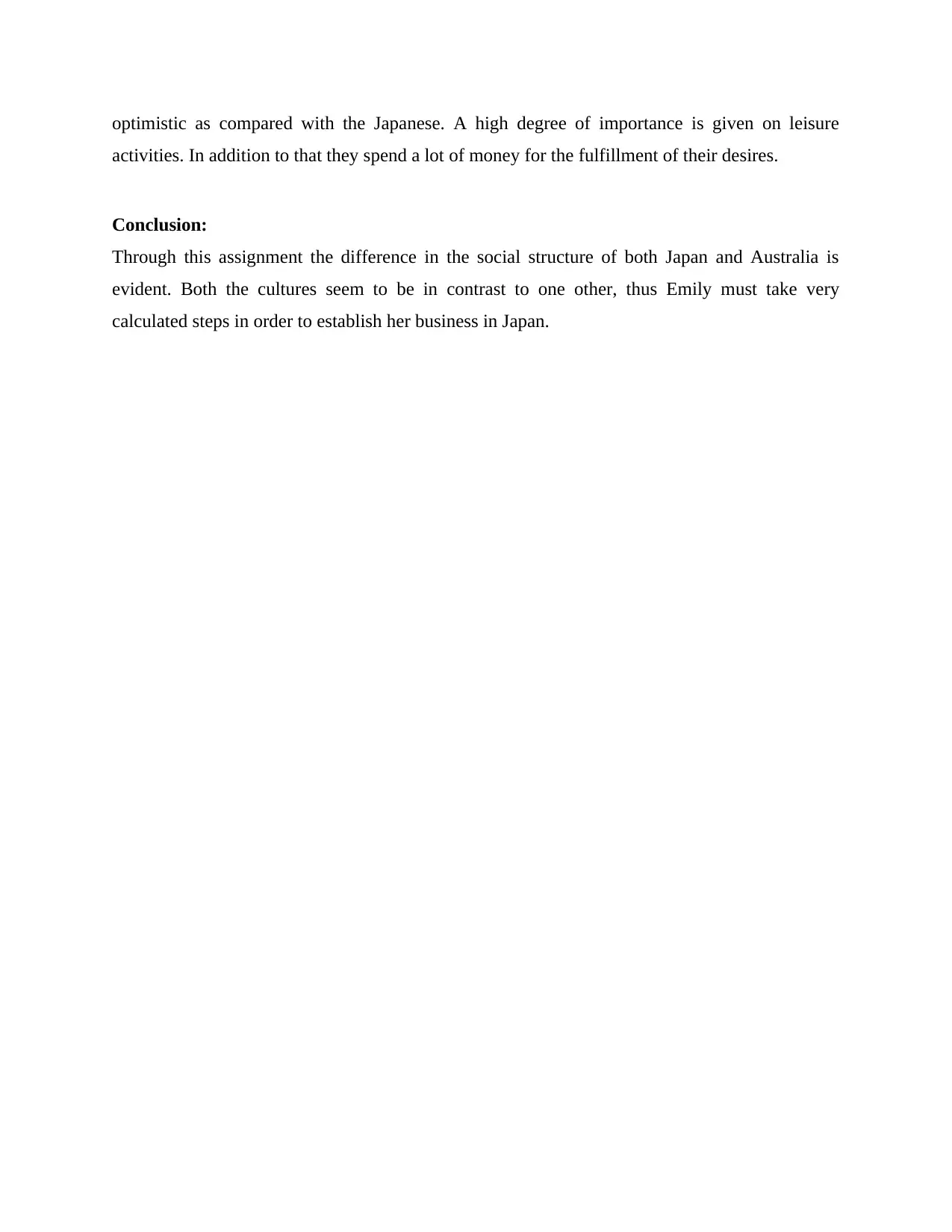
optimistic as compared with the Japanese. A high degree of importance is given on leisure
activities. In addition to that they spend a lot of money for the fulfillment of their desires.
Conclusion:
Through this assignment the difference in the social structure of both Japan and Australia is
evident. Both the cultures seem to be in contrast to one other, thus Emily must take very
calculated steps in order to establish her business in Japan.
activities. In addition to that they spend a lot of money for the fulfillment of their desires.
Conclusion:
Through this assignment the difference in the social structure of both Japan and Australia is
evident. Both the cultures seem to be in contrast to one other, thus Emily must take very
calculated steps in order to establish her business in Japan.
Paraphrase This Document
Need a fresh take? Get an instant paraphrase of this document with our AI Paraphraser
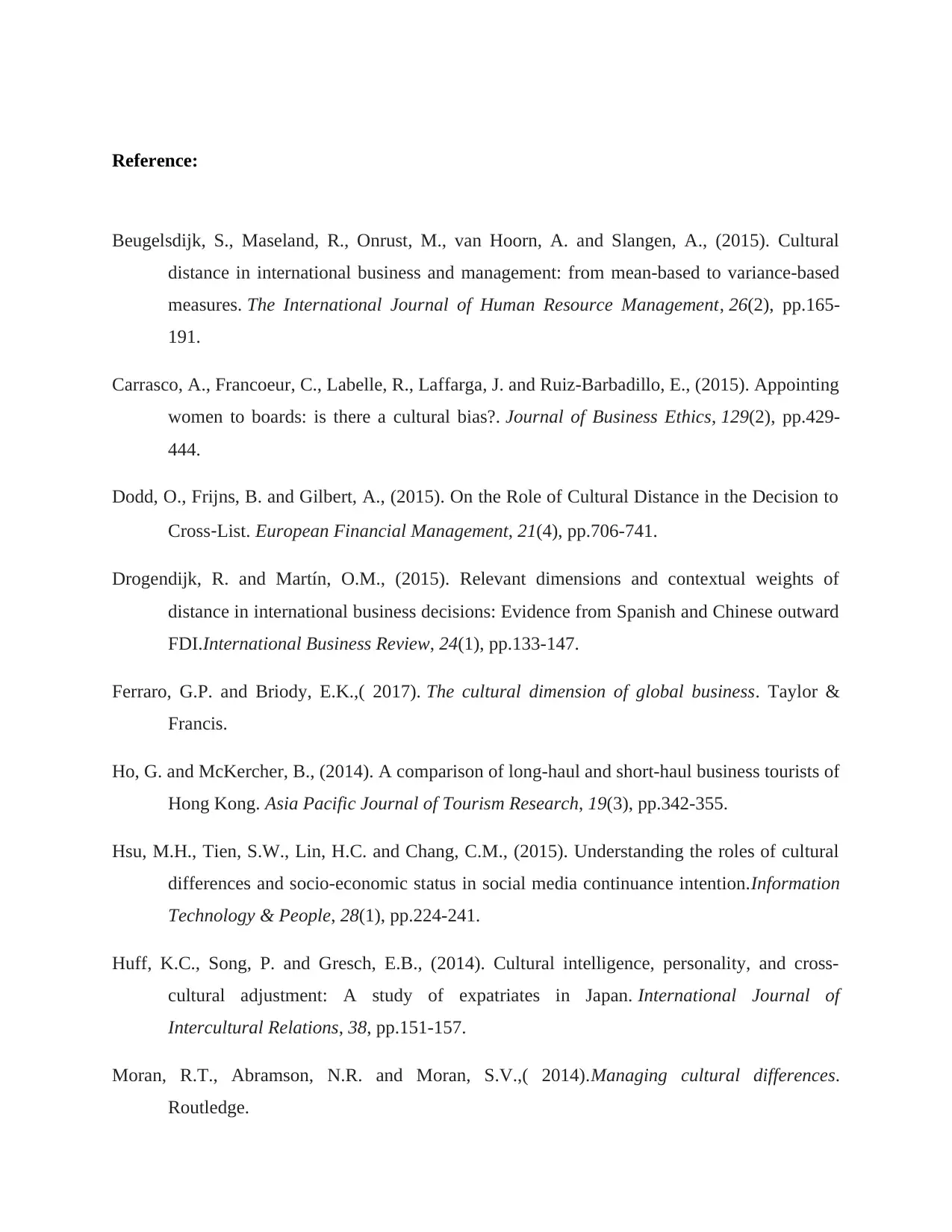
Reference:
Beugelsdijk, S., Maseland, R., Onrust, M., van Hoorn, A. and Slangen, A., (2015). Cultural
distance in international business and management: from mean-based to variance-based
measures. The International Journal of Human Resource Management, 26(2), pp.165-
191.
Carrasco, A., Francoeur, C., Labelle, R., Laffarga, J. and Ruiz-Barbadillo, E., (2015). Appointing
women to boards: is there a cultural bias?. Journal of Business Ethics, 129(2), pp.429-
444.
Dodd, O., Frijns, B. and Gilbert, A., (2015). On the Role of Cultural Distance in the Decision to
Cross‐List. European Financial Management, 21(4), pp.706-741.
Drogendijk, R. and Martín, O.M., (2015). Relevant dimensions and contextual weights of
distance in international business decisions: Evidence from Spanish and Chinese outward
FDI.International Business Review, 24(1), pp.133-147.
Ferraro, G.P. and Briody, E.K.,( 2017). The cultural dimension of global business. Taylor &
Francis.
Ho, G. and McKercher, B., (2014). A comparison of long-haul and short-haul business tourists of
Hong Kong. Asia Pacific Journal of Tourism Research, 19(3), pp.342-355.
Hsu, M.H., Tien, S.W., Lin, H.C. and Chang, C.M., (2015). Understanding the roles of cultural
differences and socio-economic status in social media continuance intention.Information
Technology & People, 28(1), pp.224-241.
Huff, K.C., Song, P. and Gresch, E.B., (2014). Cultural intelligence, personality, and cross-
cultural adjustment: A study of expatriates in Japan. International Journal of
Intercultural Relations, 38, pp.151-157.
Moran, R.T., Abramson, N.R. and Moran, S.V.,( 2014).Managing cultural differences.
Routledge.
Beugelsdijk, S., Maseland, R., Onrust, M., van Hoorn, A. and Slangen, A., (2015). Cultural
distance in international business and management: from mean-based to variance-based
measures. The International Journal of Human Resource Management, 26(2), pp.165-
191.
Carrasco, A., Francoeur, C., Labelle, R., Laffarga, J. and Ruiz-Barbadillo, E., (2015). Appointing
women to boards: is there a cultural bias?. Journal of Business Ethics, 129(2), pp.429-
444.
Dodd, O., Frijns, B. and Gilbert, A., (2015). On the Role of Cultural Distance in the Decision to
Cross‐List. European Financial Management, 21(4), pp.706-741.
Drogendijk, R. and Martín, O.M., (2015). Relevant dimensions and contextual weights of
distance in international business decisions: Evidence from Spanish and Chinese outward
FDI.International Business Review, 24(1), pp.133-147.
Ferraro, G.P. and Briody, E.K.,( 2017). The cultural dimension of global business. Taylor &
Francis.
Ho, G. and McKercher, B., (2014). A comparison of long-haul and short-haul business tourists of
Hong Kong. Asia Pacific Journal of Tourism Research, 19(3), pp.342-355.
Hsu, M.H., Tien, S.W., Lin, H.C. and Chang, C.M., (2015). Understanding the roles of cultural
differences and socio-economic status in social media continuance intention.Information
Technology & People, 28(1), pp.224-241.
Huff, K.C., Song, P. and Gresch, E.B., (2014). Cultural intelligence, personality, and cross-
cultural adjustment: A study of expatriates in Japan. International Journal of
Intercultural Relations, 38, pp.151-157.
Moran, R.T., Abramson, N.R. and Moran, S.V.,( 2014).Managing cultural differences.
Routledge.
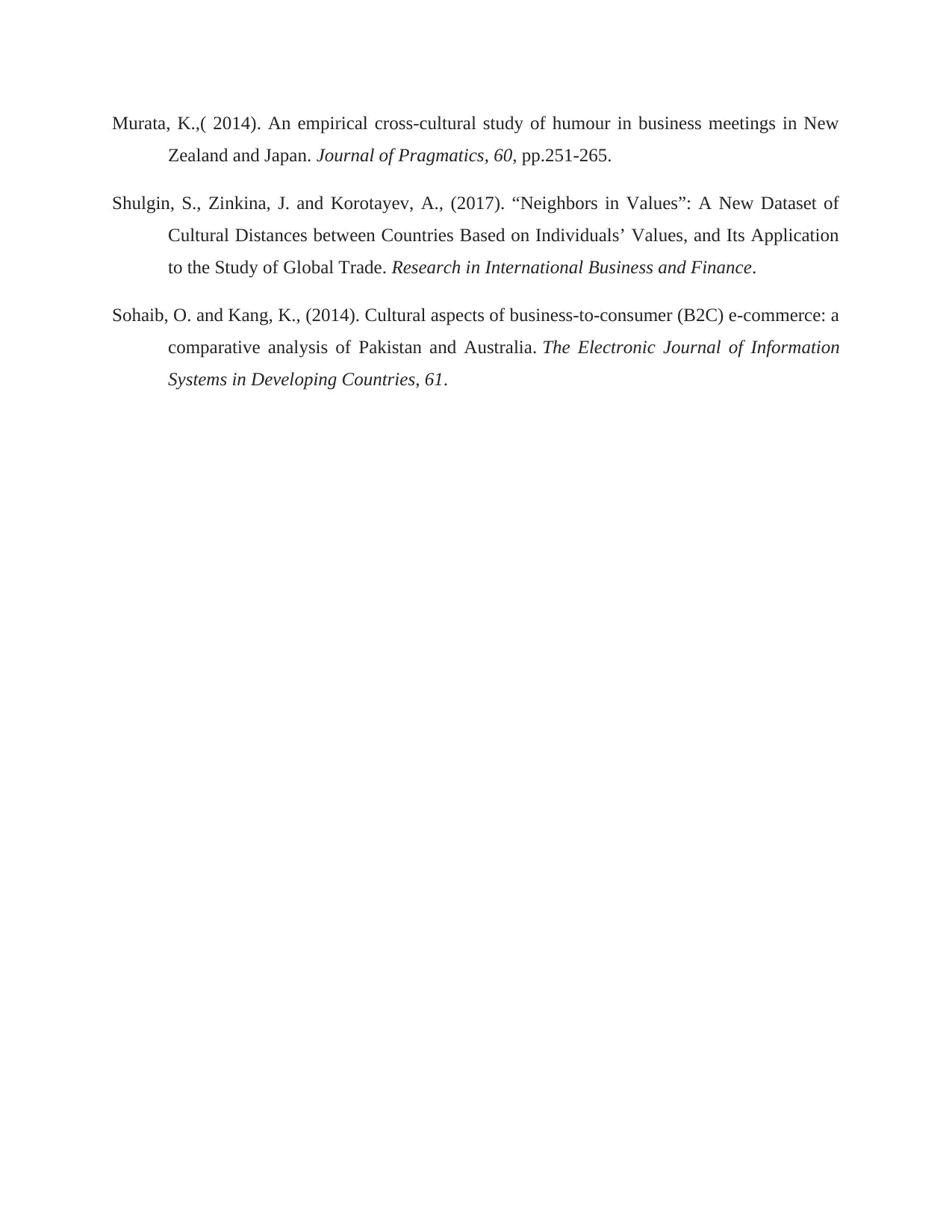
Murata, K.,( 2014). An empirical cross-cultural study of humour in business meetings in New
Zealand and Japan. Journal of Pragmatics, 60, pp.251-265.
Shulgin, S., Zinkina, J. and Korotayev, A., (2017). “Neighbors in Values”: A New Dataset of
Cultural Distances between Countries Based on Individuals’ Values, and Its Application
to the Study of Global Trade. Research in International Business and Finance.
Sohaib, O. and Kang, K., (2014). Cultural aspects of business-to-consumer (B2C) e-commerce: a
comparative analysis of Pakistan and Australia. The Electronic Journal of Information
Systems in Developing Countries, 61.
Zealand and Japan. Journal of Pragmatics, 60, pp.251-265.
Shulgin, S., Zinkina, J. and Korotayev, A., (2017). “Neighbors in Values”: A New Dataset of
Cultural Distances between Countries Based on Individuals’ Values, and Its Application
to the Study of Global Trade. Research in International Business and Finance.
Sohaib, O. and Kang, K., (2014). Cultural aspects of business-to-consumer (B2C) e-commerce: a
comparative analysis of Pakistan and Australia. The Electronic Journal of Information
Systems in Developing Countries, 61.
⊘ This is a preview!⊘
Do you want full access?
Subscribe today to unlock all pages.

Trusted by 1+ million students worldwide
1 out of 9
Related Documents
Your All-in-One AI-Powered Toolkit for Academic Success.
+13062052269
info@desklib.com
Available 24*7 on WhatsApp / Email
![[object Object]](/_next/static/media/star-bottom.7253800d.svg)
Unlock your academic potential
Copyright © 2020–2025 A2Z Services. All Rights Reserved. Developed and managed by ZUCOL.





